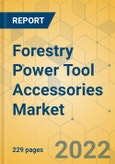Speak directly to the analyst to clarify any post sales queries you may have.
The forestry power tool accessories market is expected to grow at a CAGR of 4.98% during the forecast period
MARKET GROWTH ENABLERS
- Growth in Commercial Construction Market
- Demand For Forestry Power Tool Accessories in Residential Spaces
- Rising Demand for Implementation of Safety Guidelines
COVID-19 IMPACT
The COVID-19 outbreak has impacted the global forestry power tool accessories market on a large scale. The fall in demand for accessories is due to the closure of most retail spaces and a halt in various commercial and residential constructional activities.
KEY HIGHLIGHTS
- The low operating cost of chainsaws is driving the global forestry power tool accessories market. This is because the applications require high-quality performance tools like chainsaws used in tree falling and clearing of shrubs and greens.
- Innovation in technology by key vendors is also driving the forest power tools manufacturing industry. For instance, the evolution of eco-friendly products in the gardening and forestry industry has gained traction among manufacturers. The adoption of eco-friendly products represents the next evolution in portable power tools.
- Growth in the commercial construction market is driving the forestry machinery market. During post-pandemic, the construction market is expected to witness positive growth due to a growing demand for projects across most commercial construction work areas coupled with recovering economy.
- forestry accessories in residential spaces, contributing to the forestry power tool accessories market share. The growing urbanization is expected to show significant demand in the accessories market due to the increased firewood demand in cold countries like Canada, China, and Russia.
- It is expected that there will be a huge demand for electric chain saws as they are easy to operate, store and light in weight with a wide range of guide bars and chains.
GLOBAL FORESTRY POWER TOOL ACCESSORIES MARKET SEGMENTS
In terms of product type, the saw chains segment is likely to witness the highest growth rate at a CAGR of more than 6%, followed by trimmer lines, growing at a CAGR of 5.61% during the forecast period.
The applications of saw chains are wide. The demand for chainsaws typically increases after storms and cold winters due to cutting tree barks. This has driven the demand for chainsaws in palm oil and soybean production. In addition, cold countries like Russia, Canada, and the US see a massive demand for firewood in chilly winters due to the increase in fuel prices across the globe.
Segmentation by Product
- Saw Chains
- Guide Bars
- Trimmer Lines
- Brush Cutter Blades
- Harvester Chains
- Spark Plugs
GEOGRAPHICAL OUTLOOK
- The US residential sector supports the demand for forestry power tool accessories across North America. Factors such as government stimulus, high household incomes, and increasing demand for home improvement led to the expansion of the residential construction sector across the country.
- In APAC, forestry tools and accessories are mainly driven by Australia, China, and Japan. Moreover, Japan is considered the major contributor of wood and exports its wooden products to many countries such as China, the US, and many more. The growing demand for renovation and growing commercial infrastructure are expected to increase the demand for forestry accessories in the region.
Segmentation by Geography
- North America
- US
- Canada
- Europe
- Germany
- UK
- Italy
- France
- Spain
- Sweden
- Poland
- Netherlands
- Denmark
- Norway
- Finland
- APAC
- China
- Japan
- Australia
- Latin America
- Brazil
- Mexico
- Rest of Latin America
- Middle East & Africa
- UAE
- Saudi Arabia
- Rest of MEA
VENDOR LANDSCAPE
The key leading vendors in the global forestry accessories market are Husqvarna, STIHL, STIGA, Oregon, and MTD Products, to mention a few. The competition among these key players is intense globally. The competition between vendors is based on product offerings and pricing. Various vendors use new business models and focus on developing their product portfolios to drive growth.
Key Vendors
- Husqvarna
- MTD Products
- STIGA S.P.A
- STIHL
- Oregon
Other Prominent Vendors
- Bahco
- Cannon Bar Works
- Einhell
- Iggesund
- GB Forestry
- Kärcher
- Whites Forestry
- WORX
- Zomax
Table of Contents
Companies Mentioned
- Husqvarna
- MTD Products
- STIGA S.P.A
- STIHL
- Oregon
- Bahco
- Cannon Bar Works
- Einhell
- Iggesund
- GB Forestry
- Kärcher
- Whites Forestry
- WORX
- Zomax
Methodology
Our research comprises a mix of primary and secondary research. The secondary research sources that are typically referred to include, but are not limited to, company websites, annual reports, financial reports, company pipeline charts, broker reports, investor presentations and SEC filings, journals and conferences, internal proprietary databases, news articles, press releases, and webcasts specific to the companies operating in any given market.
Primary research involves email interactions with the industry participants across major geographies. The participants who typically take part in such a process include, but are not limited to, CEOs, VPs, business development managers, market intelligence managers, and national sales managers. We primarily rely on internal research work and internal databases that we have populated over the years. We cross-verify our secondary research findings with the primary respondents participating in the study.

LOADING...








